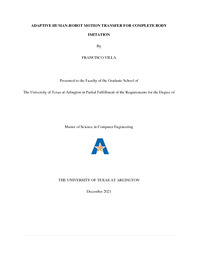
ATTENTION: The works hosted here are being migrated to a new repository that will consolidate resources, improve discoverability, and better show UTA's research impact on the global community. We will update authors as the migration progresses. Please see MavMatrix for more information.
Show simple item record
| dc.contributor.advisor | Huber, Manfred | |
| dc.creator | Villa, Francisco | |
| dc.date.accessioned | 2022-01-25T18:29:31Z | |
| dc.date.available | 2022-01-25T18:29:31Z | |
| dc.date.created | 2021-12 | |
| dc.date.issued | 2022-01-06 | |
| dc.date.submitted | December 2021 | |
| dc.identifier.uri | http://hdl.handle.net/10106/30244 | |
| dc.description.abstract | Programming robot systems to perform certain tasks is a big challenge especially if such programming is to be performed by persons who are not experts in robotics. For example, when programming a robot to serve as an exercise trainer, the person defining the motions might more naturally be a person in the exercise domain rather than a robotics expert. To address this, this thesis investigates programming by demonstration or teleoperation using full direct body motion. The goal is to reproduce gaits, gestures, and postures on a humanoid robot from observed human demonstrations. Fine motor movements such as movement of fingers will be excluded from this thesis’ paradigm.
Mimicking said such movements is straight forward if human and robot dynamics and kinematics are the same. The robot can move exactly like how his human demonstrator moves. This, however, is never the case, thus leading to a multidimensional correspondence problem. In this thesis an approach is presented that attempts to resolve this by addressing four components.
First it addresses linking the degrees of freedom of two similar but different bodies, the human, and a humanoid robot. Second, it handles linking the image frame related to the observation of the demonstrator to the demonstrator structure to be able to track locations that have changed, using
3D computer vision with a human skeleton model. As such skeleton observations are usually noisy, a third process is aimed at of filtering out sensor noise and recognition errors, resulting in an observed motion trajectory. Lastly, to account for the differences between the human and robotic bodies both in terms of kinematics and dynamic stability, a modeling and learning framework, PILCO, is adapted to address mapping into an executable imitation that obeys the stability requirements and limitations of the humanoid robot system. | |
| dc.format.mimetype | application/pdf | |
| dc.language.iso | en_US | |
| dc.subject | Robotics | |
| dc.subject | Machine learning | |
| dc.title | ADAPTIVE HUMAN-ROBOT MOTION TRANSFER FOR COMPLETE BODY IMITATION | |
| dc.type | Thesis | |
| dc.degree.department | Computer Science and Engineering | |
| dc.degree.name | Master of Science in Computer Engineering | |
| dc.date.updated | 2022-01-25T18:29:31Z | |
| thesis.degree.department | Computer Science and Engineering | |
| thesis.degree.grantor | The University of Texas at Arlington | |
| thesis.degree.level | Masters | |
| thesis.degree.name | Master of Science in Computer Engineering | |
| dc.type.material | text | |
| dc.creator.orcid | 0000-0003-2309-847X | |
Files in this item
- Name:
- VILLA-THESIS-2021.pdf
- Size:
- 1.124Mb
- Format:
- PDF
This item appears in the following Collection(s)
Show simple item record


